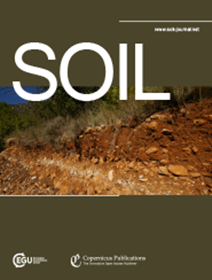Quantifying hydrological impacts of compacted sandy subsoils using soil water flow simulations: the importance of vegetation parameterization
IF 4.3
2区 农林科学
Q1 SOIL SCIENCE
引用次数: 0
Abstract
Abstract. Numerical models can quantify subsoil compaction’s hydrological impacts, useful to evaluate water management measures for climate change adaptations on compacted subsoils (e.g., augmenting groundwater recharge). Compaction also affects vegetation growth, which, however, is often parameterized using only limited field measurements or relations with other variables. Our study shows that uncertainties in vegetation parameters linked to transpiration (leaf area index [LAI]) and water uptake (root depth distribution) can significantly affect hydrological modeling outcomes. We used the HYDRUS-1D soil water flow model to simulate the soil water balance of experimental grass plots on Belgian Campine Region’s sandy soil. The compacted plot has the compact subsoil at 40–55 cm depths while the non-compacted plot underwent de-compaction. Using two year soil moisture sensor data at two depths, we calibrated and validated our models of these compacted and non-compacted plots under three different vegetation parameterizations, reflecting various canopy and root growth reactions to compaction. We then simulated the water balances under future climate scenarios. Our experiments reveal that the compacted plots exhibited lower LAI while the non-compacted plots had deeper roots. Considering these vegetations’ reactions in models, our simulations show that compaction will not always reduce deep percolation, compensated by the deep rooted non-compacted case model’s higher evapotranspiration. Therefore, this affected vegetation growth can also further influence the water balance. Hence, hydrological modeling studies on (de-)compaction should dynamically incorporate vegetation growth above- and belowground, of which field evidence is vital.利用土壤水流模拟量化压实沙质底土的水文影响:植被参数化的重要性
摘要。数值模型可以量化底土压实的水文影响,有助于评估对压实底土适应气候变化的水管理措施(例如,增加地下水补给)。压实作用也影响植被生长,然而,这通常只使用有限的实地测量或与其他变量的关系来参数化。我们的研究表明,与蒸腾(叶面积指数[LAI])和水分吸收(根深分布)相关的植被参数的不确定性会显著影响水文建模结果。采用HYDRUS-1D土壤水流模型对比利时平原沙质土壤试验田土壤水分平衡进行了模拟。压实样地在40 ~ 55 cm深度有致密的底土,而非压实样地则进行脱实处理。利用两年的土壤湿度传感器数据,我们在三种不同的植被参数化下校准并验证了这些夯实和非夯实地块的模型,反映了不同的冠层和根系生长对夯实的反应。然后,我们模拟了未来气候情景下的水平衡。我们的实验表明,密实地块的LAI较低,而非密实地块的根系较深。考虑到这些植被在模型中的反应,我们的模拟表明,压实并不总是会减少深层渗透,而深根非压实模式的蒸散量更高。因此,这种受影响的植被生长也会进一步影响水分平衡。因此,关于(脱)压实的水文模型研究应该动态地包括地上和地下的植被生长,其中现场证据是至关重要的。
本文章由计算机程序翻译,如有差异,请以英文原文为准。
求助全文
约1分钟内获得全文
求助全文
来源期刊

Soil
Agricultural and Biological Sciences-Soil Science
CiteScore
10.80
自引率
2.90%
发文量
44
审稿时长
30 weeks
期刊介绍:
SOIL is an international scientific journal dedicated to the publication and discussion of high-quality research in the field of soil system sciences.
SOIL is at the interface between the atmosphere, lithosphere, hydrosphere, and biosphere. SOIL publishes scientific research that contributes to understanding the soil system and its interaction with humans and the entire Earth system. The scope of the journal includes all topics that fall within the study of soil science as a discipline, with an emphasis on studies that integrate soil science with other sciences (hydrology, agronomy, socio-economics, health sciences, atmospheric sciences, etc.).
 求助内容:
求助内容: 应助结果提醒方式:
应助结果提醒方式:


